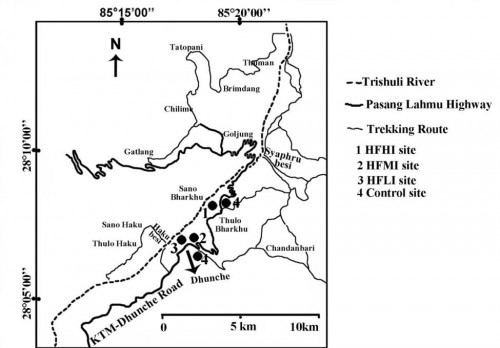Tropical Plant Research
An International Journal by Society for Tropical Plant Research
2017, VOLUME 4 ISSUE 2Pages: 297-306
Carbon sequestration and CO2 mitigation in a burned ecosystem of Pinus roxburghii forest in Langtang National Park, Nepal
Biva Aryal*, Bishnu Prasad Bhattarai, Mohan Pandey and Anjana Giri
*Society of Natural Resources Conservation and Development, Dillibazzar-33, Kathmandu, Nepal
Abstract:
Carbon (C) sequestration plays a significant role in mitigation and adaptation to the impacts of the climate change. By contrast, fire is one of the factors that can alter the carbon cycles. Extensive fire destroyed the whole forest severely and affects C sequestration. However, the impact of the surface fire has been least studied. To test the impact of surface fire on C sequestration of Pinus roxburghii forest, we measured total carbon stock of unburned (CON) and burned sites of different intensities namely: high frequency and high intensity (HFHI), high frequency and moderate intensity (HFMI), high frequency and low intensity (HFLI), in Langtang National Park, Nepal. Total tree carbon stock (above ground + below ground) was analyzed by calculating the biomass. Coverage of ground vegetation (%) was analyzed by visual estimation. The total carbon stock between the species was highly significant (P=0.00) and the highest carbon stock value was recorded in P. roxburghii species in all sites. Similarly, total CO2 mitigation in all four sites according to higher to lower values were 3346.27, 3345.16, 2484.14 and 2037.95 t.ha-1 in HFMI, HFHI, HFLI and CON, respectively. The high amounts of CO2 mitigate by HFHI and HFMI sites strongly support that forest fire limited to the surface may have a positive impact. High ground vegetation in HFMI site also suggested that the fire of medium intensity mitigate CO2 and maintains the diversity of ground vegetation as well.
Carbon (C) sequestration plays a significant role in mitigation and adaptation to the impacts of the climate change. By contrast, fire is one of the factors that can alter the carbon cycles. Extensive fire destroyed the whole forest severely and affects C sequestration. However, the impact of the surface fire has been least studied. To test the impact of surface fire on C sequestration of Pinus roxburghii forest, we measured total carbon stock of unburned (CON) and burned sites of different intensities namely: high frequency and high intensity (HFHI), high frequency and moderate intensity (HFMI), high frequency and low intensity (HFLI), in Langtang National Park, Nepal. Total tree carbon stock (above ground + below ground) was analyzed by calculating the biomass. Coverage of ground vegetation (%) was analyzed by visual estimation. The total carbon stock between the species was highly significant (P=0.00) and the highest carbon stock value was recorded in P. roxburghii species in all sites. Similarly, total CO2 mitigation in all four sites according to higher to lower values were 3346.27, 3345.16, 2484.14 and 2037.95 t.ha-1 in HFMI, HFHI, HFLI and CON, respectively. The high amounts of CO2 mitigate by HFHI and HFMI sites strongly support that forest fire limited to the surface may have a positive impact. High ground vegetation in HFMI site also suggested that the fire of medium intensity mitigate CO2 and maintains the diversity of ground vegetation as well.

Fig.: Study area in Langtang National Park showing four sites in black dots (Dhunche and Syapru VDCs of Rasuwa).
| 0 | 1 | 2 | 5 | 9 | 8 | 8 | 4 |


